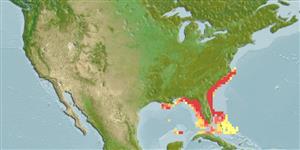>
Clupeiformes (Herrings) >
Alosidae (Shads and Sardines)
Etymology: Brevoortia: From James Carson Brevoort (1818-1887), studie the fauna from Ohio and South Caroline (Ref. 45335).
More on author: Hildebrand.
Environment: milieu / climate zone / depth range / distribution range
Ecologia
marinhas; estuarina; intervalo de profundidade 0 - 50 m (Ref. 188). Subtropical; 37°N - 23°N, 92°W - 74°W (Ref. 188)
Western Central Atlantic: Beaufort, North Carolina, to Indian River, Florida; Gulf of Mexico (Florida Bay to Louisiana, with possible break between Biscayne Bay and Florida Bay) (Ref. 188). Hybridize with B. tyrannus and B. patronus (Ref. 84218).
Tamanho / Peso / Idade
Maturity: Lm ? range ? - ? cm
Max length : 33.0 cm SL macho/indeterminado; (Ref. 37032); common length : 20.0 cm SL macho/indeterminado; (Ref. 188)
Espinhos dorsais (total): 0; Espinhos anais 0. Scutes apparent along belly; upper jaw with median notch. Pelvic fin with oblique and almost straight hind margin, the inner fin rays markedly shorter than outer fin rays when fin folded back. Pre-dorsal scales modified; scales in lateral series small and numerous, those on back and above anal fin markedly smaller than rest. A black spot behind gill opening, but none along flank (Ref. 188). Silvery, with a greenish or bluish back. Fins golden yellow (Ref. 7251).
A schooling species (but perhaps not in the northern part of its range) occurring inshore and in bays and estuaries. Feeds by filtering phytoplankton. Breeds in winter, probably November through to February or March. Eggs and larvae are planktonic (Ref. 188). Parasitic copepod found in the stomach (Ref. 37032).
Ciclo de vida ou comportamento de acasalamento
Maturidade | Reprodução | Desova | Ovos | Fecundidade | Larvas
Breeds in winter (eggs and larvae in plankton), probably November through to February or March (no data from Gulf of Mexico).
Whitehead, P.J.P., 1985. FAO Species Catalogue. Vol. 7. Clupeoid fishes of the world (suborder Clupeoidei). An annotated and illustrated catalogue of the herrings, sardines, pilchards, sprats, shads, anchovies and wolf-herrings. FAO Fish. Synop. 125(7/1):1-303. Rome: FAO. (Ref. 188)
Status na Lista Vermelha da UICN (Ref. 130435)
Ameaça para os humanos
Harmless
Uso pelos humanos
Pescarias: pouco comercial
Mais informação
ReferênciasAquaculturaPerfil para aquaculturaEstirpesGenéticaElectrophoresesHereditariedadeDoençasProcessamentoNutrientsConversão de massa
ColaboradoresFotosStamps, Coins Misc.SonsCiguateraVelocidadeTipo de nataçãoÁrea branquialOtólitosCérebrosVisão
Ferramentas
Relatórios especiais
Baixar XML
Fontes da internet
Estimates based on models
Preferred temperature (Ref.
123201): 22.9 - 26.7, mean 24.4 °C (based on 126 cells).
Índice de diversidade filogenética (Ref.
82804): PD
50 = 0.5156 [Uniqueness, from 0.5 = low to 2.0 = high].
Bayesian length-weight: a=0.00912 (0.00387 - 0.02150), b=3.06 (2.88 - 3.24), in cm total length, based on LWR estimates for this Genus-body shape (Ref.
93245).
Nível Trófico (Ref.
69278): 2.3 ±0.00 se; based on food items.
Resiliência (Ref.
120179): médio(a), tempo mínimo de duplicação da população 1,4 - 4,4 anos (Preliminary K or Fecundity.).
Fishing Vulnerability (Ref.
59153): Low to moderate vulnerability (30 of 100).
Nutrients (Ref.
124155): Calcium = 112 [64, 193] mg/100g; Iron = 1.6 [0.9, 2.7] mg/100g; Protein = 19.5 [18.3, 20.5] %; Omega3 = 0.547 [0.334, 0.873] g/100g; Selenium = 20.1 [10.7, 37.6] μg/100g; VitaminA = 10.4 [4.1, 25.4] μg/100g; Zinc = 1.33 [0.93, 1.88] mg/100g (wet weight);
